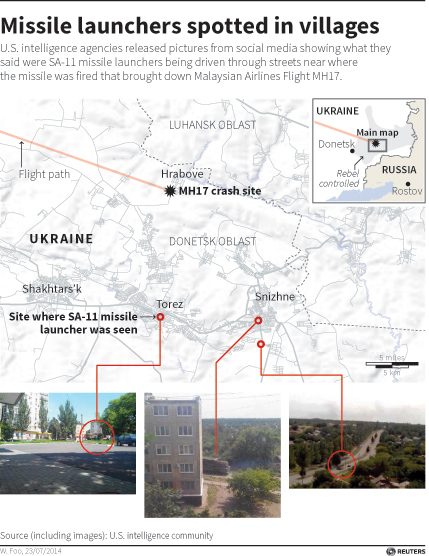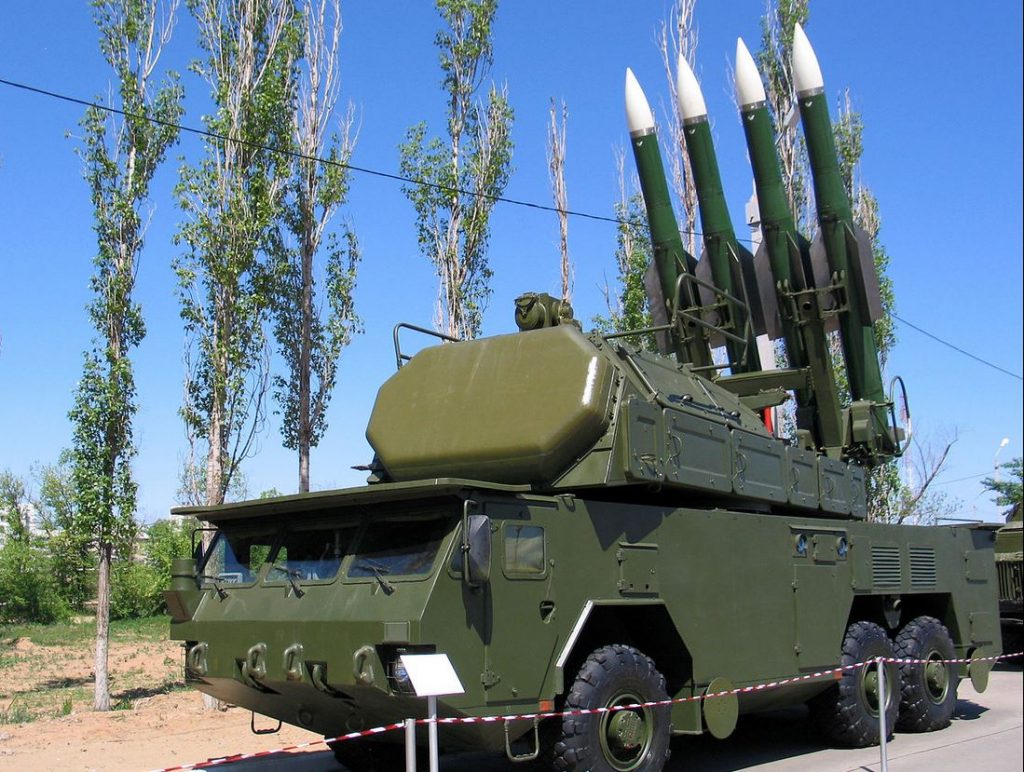Khodakovsky Blames Ukraine for Provoking What He Says Indeed May Have Been a Rebel Shootdown of MH-17
A senior commander of Russian-backed proxy forces fighting in southeast Ukraine confirmed today that the separatist militias indeed have been armed with the model of medium-range anti-aircraft missile that the US and Ukrainian governments say was used last week to destroy Malaysian Airlines Flight 17. Alexander Khodakovsky, commander of the Vostok Battalion, based in Donetsk province, told Reuters news agency that another militia group had moved a battery of the SA-11 (or “Buk”) missiles into the area where the airliner was shot down. He gave a lengthy account of the attack suggesting that the rebels had indeed fired one of the missiles to destroy the plane, and then removed the launcher to avoid having it discovered.
After the Reuters story was published, state-run Russian media said Khodakovsky denied making the remarks. [The following day, Reuters released its audio recording of Khodakovsky making the statements in the interview.]
 Khodakovsky’s comments re-affirmed rebel leaders’ declarations before the shootdown that they had deployed the SA-11s. That assertion also has been buttressed with reports and photographs by Associated Press journalists and Ukrainian citizens in the southeast of truck-mounted missiles of the SA-11’s size being driven along roads in the region. After discovering July 17 that they had shot down a civilian airliner rather than a Ukrainian military plane, the rebels’ Russian political leader, Alexander Borodai, told reporters that the separatist forces had never possessed the weapons.
Khodakovsky’s comments re-affirmed rebel leaders’ declarations before the shootdown that they had deployed the SA-11s. That assertion also has been buttressed with reports and photographs by Associated Press journalists and Ukrainian citizens in the southeast of truck-mounted missiles of the SA-11’s size being driven along roads in the region. After discovering July 17 that they had shot down a civilian airliner rather than a Ukrainian military plane, the rebels’ Russian political leader, Alexander Borodai, told reporters that the separatist forces had never possessed the weapons.
In the interview, Reuters’ Moscow-based reporter Anton Zverev, who has been reporting from Donetsk since before the Malaysian Airlines attack, quoted Khodakovsky explaining at length a narrative of the attack that accepted that the rebels had the missile. The account by Khodakovsky, who is often voluble in interviews with journalists, suggested that they had fired it because Ukrainian planes had conducted air strikes in the area. He blamed Ukrainian authorities, saying they “provoked” the attack by conducting air operations in the knowledge that the powerful missile was present and might be used.
A Buk Came from Luhansk
“I knew that a Buk came from Luhansk,” the province east of Donetsk where militants also are fighting Ukrainian forces, Reuters quotes Khodakovsky as saying. “At the time I was told that a Buk from Luhansk was coming under the flag of the LNR (the separatist “Luhansk People’s Republic”).”
“That Buk I know about,” Khodakovsky continued. “I heard about it. I think they sent it back. Because I found out about it at exactly the moment that I found out that this tragedy had taken place. They probably sent it back in order to remove proof of its presence.”
“The question is this: Ukraine received timely evidence that the volunteers [separatists] have this technology, through the fault of Russia. It not only did nothing to protect security, but provoked the use of this type of weapon against a plane that was flying with peaceful civilians,” Reuters quoted him as saying.
“They knew that this Buk existed; that the Buk was heading for Snezhnoye,” a village near the crash site, Khodakovsky said. “They knew that it would be deployed there, and provoked the use of this Buk by starting an air strike on a target they didn’t need, that their planes hadn’t touched for a week.”
“And that day, they were intensively flying, and exactly at the moment of the shooting, at the moment the civilian plane flew overhead, they launched air strikes. Even if there was a Buk, and even if the Buk was used, Ukraine did everything to ensure that a civilian aircraft was shot down.”
Who is Khodakovsky?
Hours after Reuters published its story, the Kremlin-run Russian news agency RIA-Novosti published an article quoting Khodakovsky as denying he had confirmed to Zverev the presence of the Buk. [Reuters then released its audio tape of Khodakovsky doing so.]
In a separatist movement led largely by Russian citizens, Khodakovsky is a Ukrainian national. (The Russians leading the rebels’ “Donetsk People’s Republic include its “prime minister,” Alexander Borodai; its “defense minister,” army Colonel Igor Girkin; and its “deputy prime minister,” intelligence and special operations officer Vladimir Antyufeyev.)
Under Ukraine’s previous president Viktor Yanukovych, Khodakovsky led a special forces unit called Alfa within the Security Service of Ukraine (SBU). Alpha gunmen were accused of shooting anti-Yanukovych and pro-democracy demonstrators in Kyiv in January. Khodakovsky left his post after Yanukovych fled Ukraine in February, and joined the separatist movement.
Khodakovsky’s importance in the movement is magnified because his unit, the Vostok (Russian for “East”) Battalion, exercises control in the center of Donetsk, the largest city in southeast Ukraine and the effective headquarters of the rebel movement. Vostok attacked other rebel fighters in Donetsk last month, seizing control of the provincial offices. Mark Galeotti, a professor at New York University now researching Russian affairs in Moscow, described that assault as an act by Russia’s military intelligence agency, the GRU, to re-assert Kremlin control over rival militia factions.
James Rupert is an editor at the Atlantic Council.
Image: One version of Russia's truck-mounted SA-11 ("Buk") missile system was on display at Russia's Kapustin Yar rocket development center in 2011. (Creative Commons/Wikipedia)
